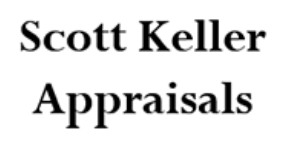A live weekly radio adventure through Indiana history with host Nelson Price.
Show airs live from noon to 1 p.m. ET each Saturday on WICR 88.7 FM in Indianapolis. Or install the WICR HD 1 app on your cell phone or computer and stream live from anywhere.
October 01, 2022
Cemeteries and their historic landscaping
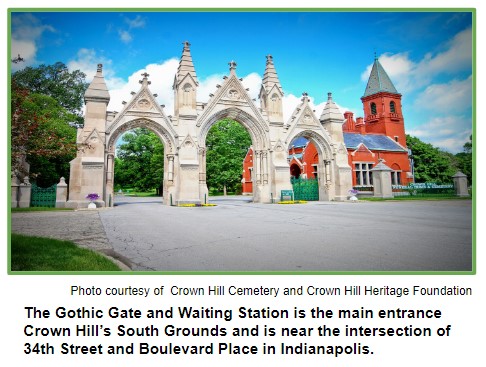
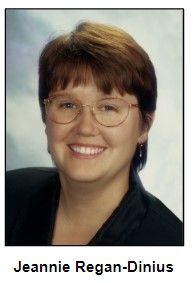 Just as cities and small towns in Indiana have evolved during more than 200 years of statehood, so have their cemeteries. Hoosier History Live will explore that evolution, particularly the changes in the ways cemeteries have been designed and landscaped.
Just as cities and small towns in Indiana have evolved during more than 200 years of statehood, so have their cemeteries. Hoosier History Live will explore that evolution, particularly the changes in the ways cemeteries have been designed and landscaped.
This will include a look at the Rural Cemetery Movement that began in the mid-1800s and involved creating professionally designed cemeteries in park-like settings. Several of the largest cemeteries in the state, from Indianapolis and Fort Wayne to Terre Haute and Evansville, were created as part of the Rural Cemetery Movement.
Before that movement, graveyards in the early 1800s were much different, says Jeannie Regan-Dinius, director of historic preservation at Crown Hill Heritage Foundation in Indianapolis. She will be Nelson's guest to share insights about the evolution of cemetery design as well as challenges that currently confront cemeteries across the state as, in her words, they "struggle with the historic landscape, the upkeep of tombstones, mausoleums and the natural environment. The debate over which is more important, the landscape or the tombstones, pulls on funds, volunteer time and decisions made."
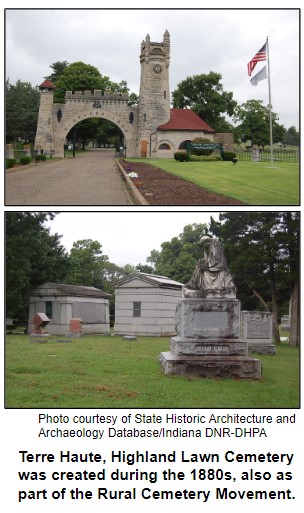 In the early 1800s, burials were typically done on church-owned land or in town cemeteries, Jeannie notes. "Graves were laid facing east and west, with the head to the west. All available space was used, with burials very close together and, at times, on top of each other."
In the early 1800s, burials were typically done on church-owned land or in town cemeteries, Jeannie notes. "Graves were laid facing east and west, with the head to the west. All available space was used, with burials very close together and, at times, on top of each other."
As cities and towns grew, their cemeteries began to fill up. Burial grounds then moved out of the center of the cities. Jeannie notes this spawned the Rural Cemetery Movement. "These cemeteries were professionally designed, followed topography, had burials facing a variety of directions, and encouraged plantings."
In Indiana, the movement included the creation of Lindenwood Cemetery in Fort Wayne and Oak Hill Cemetery in Evansville during the 1850s. Others are Highland Lawn Cemetery in Terre Haute, which was created in the 1880s, and Crown Hill Cemetery in Indianapolis.
Created during the 1860s, Crown Hill became (and remains) the third largest private cemetery in the country. Hoosier History Live explored the history of Crown Hill during a show in 2014.
"Even in communities without the funds to create the professionally landscaped, park-like settings, they used hints of the (Rural Cemetery Movement) in their local cemeteries," Jeannie Regan-Dinius says.
Before joining the staff at the Crown Hill Heritage Foundation in July, Jeannie had an extensive background in historic cemetery preservation and research at Indiana DNR's Division of Historic Preservation and Archaeology. She also was involved in Underground Railroad research with the state. Her civic endeavors include serving for more than six years on the board of the Indiana Women's History Association and a stint on the board of the Indiana Historical Society.
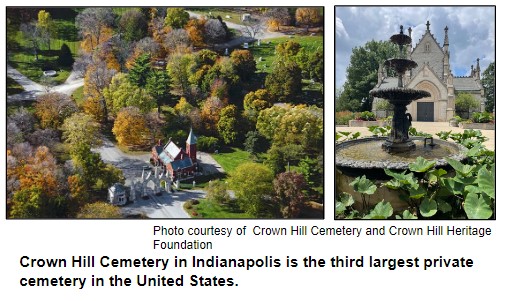
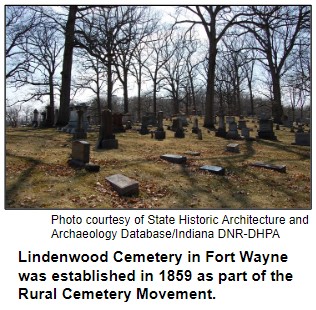
Your contributions helps keep Hoosier History Live on the air, on the web and in your inbox!

We'd like to thank the following recent individual contributors who make this show possible. For a full list of contributors over the years, visit Support the Show on our website.
- In memory of William (Bill) Mihay by Bob Wakefield
- Florence and John Stanton
- Aleta Hodge
- Peggy Hollingsworth
- Lorraine Phillips Vavul
- Margaret Smith
- Jane Hodge
- Jeff Price
- Joe Young
- Sue and Craig Thomson
- Richard Vonnegut
- Jim Lindgren
- Ken and Luan Marshall
Roadtrip: Crystal Springs Creamery in Osceola
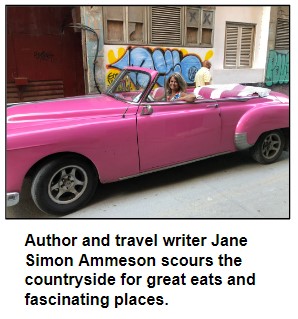 Guest Roadtripper and author and travel writer Jane Ammeson recommends a visit to Crystal Springs Creamery in Osceola. It’s between South Bend and Elkhart in the northern part of the state. As she tells us, “Though it seems far from anywhere, the creamery is a bustling place. The farm store, located in a large 40-year-old barn, also sells fresh produce, grass-fed beef and pork, pastries from the Amish-owned and operated Country Lane Bakery in nearby Middlebury, jars of canned goods including jams and pickles, and the products produced from the farm’s 300 dairy cows. These include yogurts, squeaky cheese curds (the squeak tells you they’re fresh), butter, and flavored milks such as banana, root beer, and orange in glass bottles and made using Low Temperature Vat Pasteurization, an old-fashioned method."
Guest Roadtripper and author and travel writer Jane Ammeson recommends a visit to Crystal Springs Creamery in Osceola. It’s between South Bend and Elkhart in the northern part of the state. As she tells us, “Though it seems far from anywhere, the creamery is a bustling place. The farm store, located in a large 40-year-old barn, also sells fresh produce, grass-fed beef and pork, pastries from the Amish-owned and operated Country Lane Bakery in nearby Middlebury, jars of canned goods including jams and pickles, and the products produced from the farm’s 300 dairy cows. These include yogurts, squeaky cheese curds (the squeak tells you they’re fresh), butter, and flavored milks such as banana, root beer, and orange in glass bottles and made using Low Temperature Vat Pasteurization, an old-fashioned method."
"Our biggest sellers are chocolate, of course," said Tim Martin who runs the farm along with his two sons, Troy and Donovan. Martin says he started making cheese because he wanted to take his milk directly to the people.
The Martins are into sustainable practices: the glass milk jars are returnable, and the whey from the 1300 pounds of cheese they produce each week is used in the cow feed and to fertilize the fields.
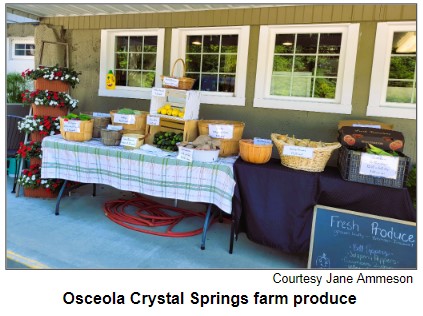
"Also, milk just tastes better in glass bottles. It really does. And the creamery is one of the stops on Indiana Foodways Cheese Trail."
Hoosier History Live looks back . .
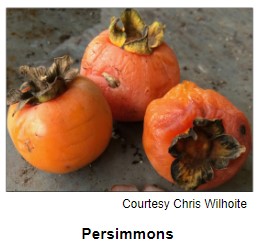 . . . to our show "Persimmons and Pawpaws with Jo Ellen Meyers Sharp" originally recorded live at WICR studios on August 12, 2017. The nip of fall is in the air, and aren’t you glad Hoosier History Live has painstakingly preserved all of our show audio and enewsletters over the years? True, some of our old work is held together with straw and baling wire, and radio technology has completely changed since we first went on the air in January of 2008. And some of you tell us that you listen to us entirely on podcast, which we are trying to get a handle on.
. . . to our show "Persimmons and Pawpaws with Jo Ellen Meyers Sharp" originally recorded live at WICR studios on August 12, 2017. The nip of fall is in the air, and aren’t you glad Hoosier History Live has painstakingly preserved all of our show audio and enewsletters over the years? True, some of our old work is held together with straw and baling wire, and radio technology has completely changed since we first went on the air in January of 2008. And some of you tell us that you listen to us entirely on podcast, which we are trying to get a handle on.
At any rate, here you can have a listen to the Persimmons and Pawpaws show while you check out that new recipe for persimmon pudding!
Molly Head, executive producer (317) 506-7164
Ryan DeRome, associate producer
Cheryl Lamb, administrative manager
Richard Sullivan, senior tech consultant
Pam Fraizer, graphic designer
Kathleen Madinger Angelone, Garry Chilluffo, consultants
"...best Americana-themed show..."
"Hoosier History Live is the best Americana-themed show anywhere on radio!"
- John Guerrasio, former IRT actor
"...fun and interesting..."
"Hoosier History Live is a fun and interesting way to learn about the heart and soul of Indiana. No boring classes or books here! The production team does an outstanding job."
- Judy O'Bannon, civic leader and public broadcasting producer
Please tell our sponsors that you appreciate their support!

 Acknowledgments to WICR-FM, Fraizer Designs, The Indiana Album, Monomedia, Indiana Historical Bureau, Indiana Landmarks, Henri Pensis, Kielynn Tally, Genesis Brown, Leticia Vasselli, Heather McIntyre, and many other individuals and organizations. We are independently produced and are self-supporting through organizational sponsorship and through individual contribution at the yellow button on our newsletter or website. For organizational sponsorship, which includes logos, links, and voiced credits in the show, contact Molly Head at (317) 506-7164 or email her at molly@hoosierhistorylive.org. Our media reach continues to grow via podcasting.
Acknowledgments to WICR-FM, Fraizer Designs, The Indiana Album, Monomedia, Indiana Historical Bureau, Indiana Landmarks, Henri Pensis, Kielynn Tally, Genesis Brown, Leticia Vasselli, Heather McIntyre, and many other individuals and organizations. We are independently produced and are self-supporting through organizational sponsorship and through individual contribution at the yellow button on our newsletter or website. For organizational sponsorship, which includes logos, links, and voiced credits in the show, contact Molly Head at (317) 506-7164 or email her at molly@hoosierhistorylive.org. Our media reach continues to grow via podcasting.
© 2022 Hoosier History Live. All rights reserved.
|

